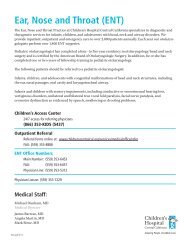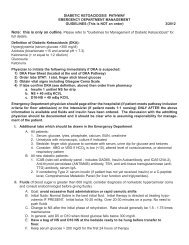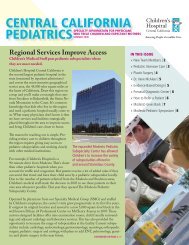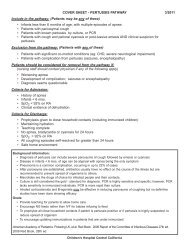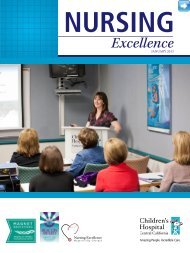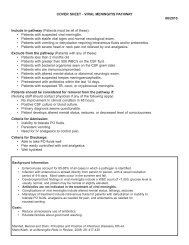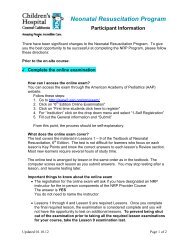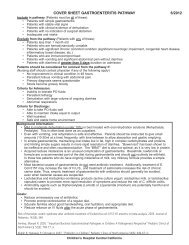CENTRAL CALIFORNIA PEDIATRICS - Children's Hospital Central ...
CENTRAL CALIFORNIA PEDIATRICS - Children's Hospital Central ...
CENTRAL CALIFORNIA PEDIATRICS - Children's Hospital Central ...
Create successful ePaper yourself
Turn your PDF publications into a flip-book with our unique Google optimized e-Paper software.
CONTINUED FROM PREVIOUS PAGE<br />
chart for gestational age at discharge),<br />
to increase by 70% the number of<br />
infants started on feeds within the<br />
first 3 days of life, and finally to increase<br />
by 50% the number of infants<br />
started on Total Parenteral Nutrition<br />
(TPN) within 6 hours of life.<br />
A year into the Collaborative<br />
and improvements have been<br />
demonstrated in all three of the<br />
identified measurement points. At<br />
the beginning of the study 32% of<br />
the patients were at the desired 10th<br />
percentile. Today, 59% of patients<br />
reach that goal. By the time the study<br />
ends in 2009 it is expected that 85 –<br />
90% of patients under 1,500 grams<br />
will reach this goal. Time to TPN<br />
is down 30%. That’s good progress<br />
and the team expects to meet all<br />
goals and be able to share its data<br />
and experiences with the rest of the<br />
Collaborative next year.<br />
Additional performance improvement<br />
areas being addressed by Children’s<br />
NICU in year two of the Collaborative<br />
are to reduce by 50% the incidence of<br />
catheter associated blood stream infections<br />
and late bacterial infections in all<br />
weight strata by November 1, 2008.<br />
Besides gathering and sharing data and<br />
research, the hospitals participating<br />
in the Collaborative meet twice a<br />
year to discuss and learn from each<br />
other in a face-to-face environment.<br />
Meetings include interactive plenary<br />
presentations by experts in health care<br />
quality and safety, small and large group<br />
exercises, and a learning fair in which<br />
teams share improvement examples.<br />
All of the LIC’s are guided by a common<br />
set of themes. Every process<br />
should be improved in such a way as<br />
to achieve results related to the themes<br />
adapted from the Institute of Medicines<br />
Principles (Crossing the Quality<br />
Chasm, IOM, 2001).<br />
Focus on Intensive Care<br />
PICU Measurement<br />
Unit benchmarked in the nation’s top 10%.<br />
The Pediatric Intensive Care Unit<br />
(PICU) at Children’s <strong>Hospital</strong> <strong>Central</strong><br />
California is one of the largest PICUs<br />
in the country based on bed capacity,<br />
but it’s another ranking that matters<br />
most. In the field of intensive care,<br />
severity adjusted mortality rate is a key<br />
baseline benchmark, and in this arena<br />
Children’s PICU is ranked in the best<br />
10% in the country.<br />
The PICU is licensed for 34 beds and<br />
is a combined medical/surgical unit.<br />
The most recent expansion of six additional<br />
beds was completed in the fall<br />
of 2007. Twelve of the ICU rooms are<br />
equipped to convert to surgical suites<br />
if an emergent event presents itself.<br />
The mortality rates are collated from<br />
a validated data set which consistently<br />
ranks Children’s in the top 1-2 PICU’s<br />
out of 33 benchmarked units for the<br />
past decade. Great teamwork between<br />
the PICU staff, transport team (both<br />
ground and air), and a board certified<br />
pediatric intensivist group, on duty<br />
around-the-clock, contribute not only<br />
to the PICU’s great outcome data<br />
but also to the Unit’s high patient<br />
satisfaction scores. The intensivists’<br />
presence means that attending<br />
physicians are always in the Unit, and<br />
residents are never left without the<br />
support of an experienced specialist.<br />
Achieving this level of success is a<br />
result of constant efforts to improve<br />
quality and performance. Children’s<br />
PICU is currently engaged in a number<br />
of projects toward that end. For<br />
example, the PICU has initiated an<br />
electronic insulin protocol research<br />
study for non-diabetic patients in<br />
which well established protocols are<br />
applied and then adjusted based on a<br />
Dr. Newton Seiden, Intensivist and<br />
Children’s <strong>Hospital</strong> Chief of Staff.<br />
prescribed dataset for the individual<br />
patient. To date this ongoing study has<br />
proved to be simple to implement and<br />
outcome positive. Additionally, the<br />
PICU is part of a collaborative within<br />
NACHRI (National Association of<br />
Children’s Health and Related Institutions)<br />
to reduce catheter associated<br />
blood stream infections. This research<br />
project is part of a national collaborative<br />
which has completed Phase I with<br />
a significant reduction of blood stream<br />
infections and is now embarking on<br />
Phase II which will add additional<br />
study and refinement to both insertion<br />
and care of central lines.<br />
Children’s PICU will continue to<br />
seek opportunities to improve the<br />
level of quality and service to patients,<br />
their families and customers. An<br />
additional eight bed PICU expansion<br />
will be completed in approximately<br />
three years.<br />
Children’s <strong>Hospital</strong> <strong>Central</strong> California | 3>>



